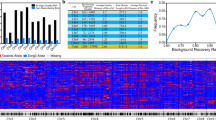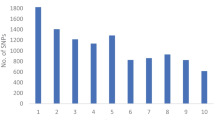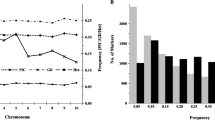Abstract
It has been claimed that the system that delivers the products of plant breeding reduces the diversity of cultivated varieties leading to an increased genetic vulnerability. The main goal of our study was to monitor the temporal trends in genetic diversity over the past five decades among maize cultivars with the largest acreage in Central Europe. Our objectives were to (1) investigate how much of the genetic diversity present in important adapted open-pollinated varieties (OPVs) has been captured in the elite flint germplasm pool, (2) examine changes in the genetic diversity among the most important commercial hybrids as well as in their dent and flint parents, (3) analyze temporal changes in allele frequencies between the dent and flint parental inbreds, and (4) investigate linkage disequilibrium (LD) trends between pairs of loci within the set of parental dent and flint lines. We examined 30 individuals of five prominent OPVs from Central Europe, 85 maize hybrids of economic importance, and their dent and flint parental components with 55 SSRs. LD was significant at probability level P=0.01 for 20.2% of the SSR marker pairs in the 82 dent lines and for 17.2% in the 66 flint lines. The dent and flint heterotic groups were clearly separated already at the beginning of hybrid breeding in Central Europe. Furthermore, the genetic variation within and among varieties decreased significantly during the five decades. The five OPVs contain numerous unique alleles that were absent in the elite flint pool. Consequently, OPVs could present useful sources for broadening the genetic base of elite maize breeding germplasm.


Similar content being viewed by others
References
Allard RW, Bradshaw AD (1964) Implications of genotype-environment interactions in applied plant breeding. Crop Sci 4:503–508
Comstock RE, Robinson HF, Harvey PH (1949) A breeding procedure designed to make maximum use of both general and specific combining ability. J Am Soc Agron 41:360–367
Duvick DN, Smith JSC, Cooper M (2004a) Changes in performance, parentage, and genetic diversity of successful corn hybrids, 1930–2000. In: Smith CW, Betran J, Runge ECA (eds) Corn: Origin, History, Technology, and Production. Wiley, New York, pp 65–97
Duvick DN, Smith JSC, Cooper M (2004b) Long-term selection in a commercial hybrid maize breeding program. Plant Breed Rev 24:109–151
Falconer DS, Mackay TF (1996) Introduction to Quantitative Genetics, 4th edn. Longman Group Ltd, London
Gower JC (1966) Some distance properties of latent root and vector methods used in multivariate analysis. Biometrika 53:325–338
Hallauer AR, Russell WA, Lamkey KR (1988) Corn breeding. In: Sprague GF, Dudley JW (eds) Corn and Corn Improvement, 3rd edn. Agron Monogr 18, ASA, CSSA, and SSSA, Madison, WI, pp 463–564
Hartigan JA, Wong MA (1979) A K-means clustering algorithm. Appl Stat 28:100–108
Hollander M, Wolfe DA (1973) Nonparametric statistical inference. Wiley, New York, pp 139–146
Ihaka R, Gentleman R (1996) A language for data analysis and graphics. J Comput Graph Stat 5(3):299–314
Lu H, Bernardo R (2001) Molecular marker diversity among current and historical maize inbreds. Theor Appl Genet 103:613–617
Lübberstedt T, Melchinger AE, Dussle C, Vuylsteke M, Kuiper M (2000) Relationships among early European maize inbreds: IV. Genetic diversity revealed with AFLP markers and comparison with RFLP, RAPD, and pedigree data. Crop Sci 40:783–791
Mackay IJ, Gibson JP (1993) The effects of gametic-phase disequilibrium on the prediction of response to recurrent selection in plants. Theor Appl Genet 87:152–160
Maurer HP, Melchinger AE, Frisch M (2004) Plabsoft: Software for simulation and data analysis in plant breeding. XVIIth EUCARPIA General Congress 2004, Tulln, Austria, pp 359–362
Messmer MM, Melchinger AE, Boppenmaier J, Brunklaus-Jung E, Herrmann RG (1992) Relationships among early European maize inbreds: I. Genetic diversity among flint and dent lines revealed by RFLPs. Crop Sci 32:1301–1309
Oettler G, Schnell FW, Utz HF (1976) Die westdeutschen Getreide- und Kartoffelsortimente im Spiegel ihrer Vermehrungsflächen. In: Alleweldt G (ed) Hohenheimer Arbeiten. Schriftenreihe der Universität Hohenheim Reihe: Pflanzliche Produktion. Verlag Eugen Ulmer, Stuttgart, Germany
Rebourg C, Gouesnard B, Welcker C, Dubreuil P, Chastanet M, Charcosset A (2003) Maize introduction into Europe: the history reviewed in the light of molecular data. Theor Appl Genet 106:895–903
Reif JC, Hamrit S, Heckenberger M, Schipprack W, Bohn M, Melchinger AE (2005) Genetic structure and diversity among European flint maize populations determined with SSRs. Theor Appl Genet (in press)
Roger JS (1972) Measures of genetic similarity and genetic distance. Studies in genetics. VII. Univ Tex Publ 7213:145–153
Saghai-Maroof MA, Soliman KM, Jorgenson R, Allward RW (1984) Ribosomal DNA spacer length polymorphisms in barley: Mendelian inheritance, chromosomal location and population dynamics. Proc Natl Acad Sci USA 81:8014–8018
Schnell FW (1992) Maiszüchtung und die Züchtungsforschung in der Bundesrepublik Deutschland. Vorträge Pflanzenzüchtung 22:27–44
Stojsin D, Kannenberg LW, Rajnpreht J, Pauls PK, Stojsin R (1996) Genetic relationships among commercial corn hybrids and parents based on RAPD analyses of pericarp and embryo DNA. Genetika 28:137–150
UPOV (2002) General introduction to the examination of distinctness, uniformity and stability and the development of harmonized descriptions of new varieties of plants. TG/1/3. Geneva
Wang J, Zhong GY, Chin ECL, Register JC, Riley RD, Niebur WS, Smith JSC (2002) Identification of parents of F1 hybrids through SSR profiling of maternal and hybrid tissue. Euphytica 124:29–34
Weir BS (1996) Genetic Data Analysis II, 2nd edn. Sinauer Associates Inc, Sunderland, MA
Wright S (1978) Evolution and Genetics of Populations, vol IV. The Univ of Chicago Press, p 91
Acknowledgements
This research was part of project ‘Genetic Diversity in Agriculture: Temporal Flux, Sustainable Productivity and Food Security’, which was supported by a research grant from the European Union in Framework 5 “Quality of life and management of living resources program” (QLRT-2000–00934). We gratefully acknowledge the technical assistance of Ms. E. Kokai-Kota in generating part of the SSR data.
Author information
Authors and Affiliations
Corresponding author
Additional information
Communicated by A. Charcosset
Rights and permissions
About this article
Cite this article
Reif, J.C., Hamrit, S., Heckenberger, M. et al. Trends in genetic diversity among European maize cultivars and their parental components during the past 50 years. Theor Appl Genet 111, 838–845 (2005). https://doi.org/10.1007/s00122-005-0004-5
Received:
Accepted:
Published:
Issue Date:
DOI: https://doi.org/10.1007/s00122-005-0004-5




